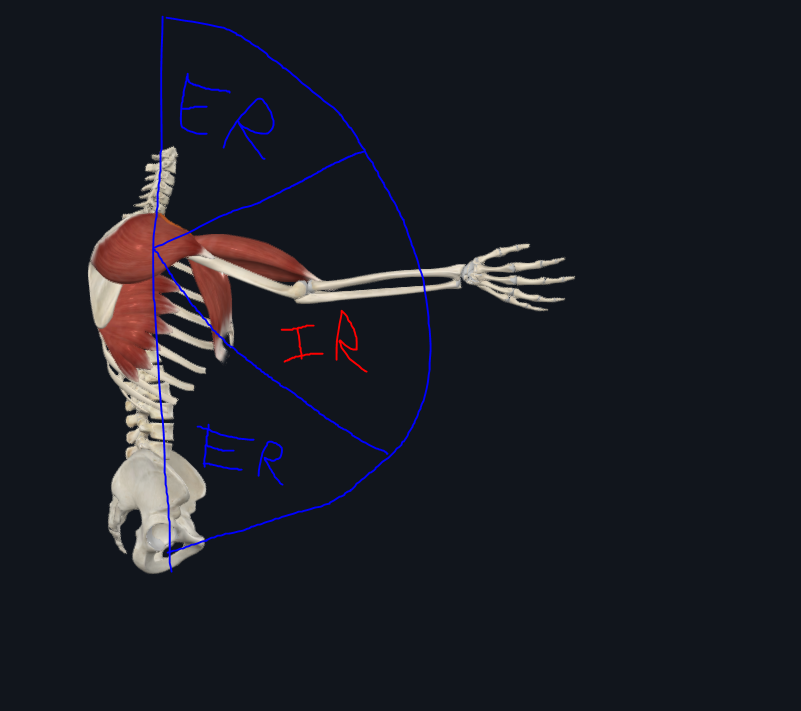Arm Training for Improved Shoulder Mobility - Biceps and Triceps Breakdown with Examples
When we think about improving shoulder mobility, many think to target the rotator cuff with your typical external and internal rotation exercises. Aside from this, many will also gravitate towards stretches to “elongate” the lats and pecs under the presumption that this will lead to increased mobility. I have written already about what stretching does and its effects in a previous post, but in this post I want to present some other methods for improving shoulder mobility by focusing on the shoulder flexion arc and how arm training can actually be valuable in this scenario.
Shoulder Flexion Arc
The shoulder flexion arc follows the gait cycle in that it has components of both external and internal rotation at each given range.
0-60° of flexion - External Rotation (scapula “protracts”/internally rotates; proximal humerus will externally rotate in relation)
60-120° of flexion - Internal Rotation (scapula “retracts”/externally rotates; proximal humerus will internally rotate in relation)
120+° of flexion - External Rotation (scapula will upwardly and internally rotate; proximal humerus will re-externally rotate in relation)
Shoulder flexion arc
Credit: Complete Anatomy app by Elsevier
This is essentially scapulohumeral rhythm in action. The scapula must retain relative motion with the proximal humerus for the shoulder to have access to sufficient mobility. Failure to do so will result in lost range of motion and potentially pain and tightness in associated areas (between the shoulder blade and spine + upper trap). When people run into this issue, they will resort to the normal stuff - stretch one part and strengthen another part. Both methods introduce tension - this isn’t what we need. When it comes to improving shoulder mobility, arm training is an under-utilized tool that can serve as the solution.
Biceps and External Rotation
Biceps brachii origin points
C = clavicle / S = scapula / H = humerus
Credit: Complete Anatomy app by Elsevier
The biceps have both origin points on the scapula. Since muscles pull on both origin and insertion points (more on this in another post), the biceps have a contribution to scapulohumeral rhythm that is under-appreciated. Through it’s contraction, it will pull the scapula into its internally rotated state and also externally rotate the proximal ulna, since it inserts there. Since the scapula is internally rotated, you will have the limb being moved into a bias of external rotation. We can use this to improve external rotation of the shoulder via 3 key exercises I use all the time:
Seated Concentration Curl
Credit: Complete Anatomy app by Elsevier
The seated concentration curl position the arm into its external rotation arc, deloads the body since we are seated, and works the biceps, which we established is a prime player in the external rotation capability of the shoulder (and elbow as well).
Preacher Curl
Credit: Complete Anatomy app by Elsevier
The preacher curl is a fantastic exercise for hypertrophy, but can also double down as a way to improve the mobility of the shoulder. The principle here is the exact same - position the arm in its ER arc and work the biceps.
Spider Curl
Credit: Complete Anatomy app by Elsevier
The spider curl is a challenging arm exercise that improves external rotation by nature of the position. With the help of gravity, the limb position will also promote expansion of back muscles as you execute the exercise.
Triceps and Internal Rotation
Triceps brachii long head origin point
S = scapula
Credit: Complete Anatomy app by Elsevier
The triceps have 3 heads - the medial head, lateral head, and long head. The medial and lateral heads are more relevant when it comes to elbow range of motion, but things get interesting when we look at the attachment points of the long head. The long head originates on the scapula and therefore contributes to its motion. When it contracts, it will bring the scapula into an externally rotated state while internally rotating the proximal ulna. Since the scapula is externally rotated, the limb will be biased towards internal rotation. In this situation, we have more versatility with the exercises we can use:
Skullcrushers
Credit: Complete Anatomy app by Elsevier
The skullcrusher starts us in the position of internal rotation already. Skullcrushers are also a great hypertrophy exercise and can double as a way to improve shoulder internal rotation.
Tricep Pushdown
Credit: Complete Anatomy app by Elsevier
The next 2 exercises are a bit interesting since the arm is at the side of our body. When the arm is positioned to our side, we are internally rotated. By hitting the triceps using a cable pushdown and keeping the humerus at our side, we can still effectively improve shoulder internal rotation.
Tricep Kickback
Credit: Complete Anatomy app by Elsevier
The kickback is not top of the list for many people when it comes to triceps training, but it has a very useful application for improving shoulder internal rotation. It follows the same principle as the cable pushdown in that the arm is at the side of your body, but has an added benefit of having the body face the ground, which will help to expand the anterior side of the ribcage (the front of the ribcage must be able to expand to internally rotate the shoulder).
Final Thoughts
When we start to look at the human body in a broader scope, we can start to see different interactions within the body than what we are accustomed to knowing. Many simply see the biceps and triceps as just elbow muscles - but they can have profound effects on the mobility of the shoulder as a whole. The body does not exist in isolation, and learning to zoom out can be helpful in choosing different interventions.








